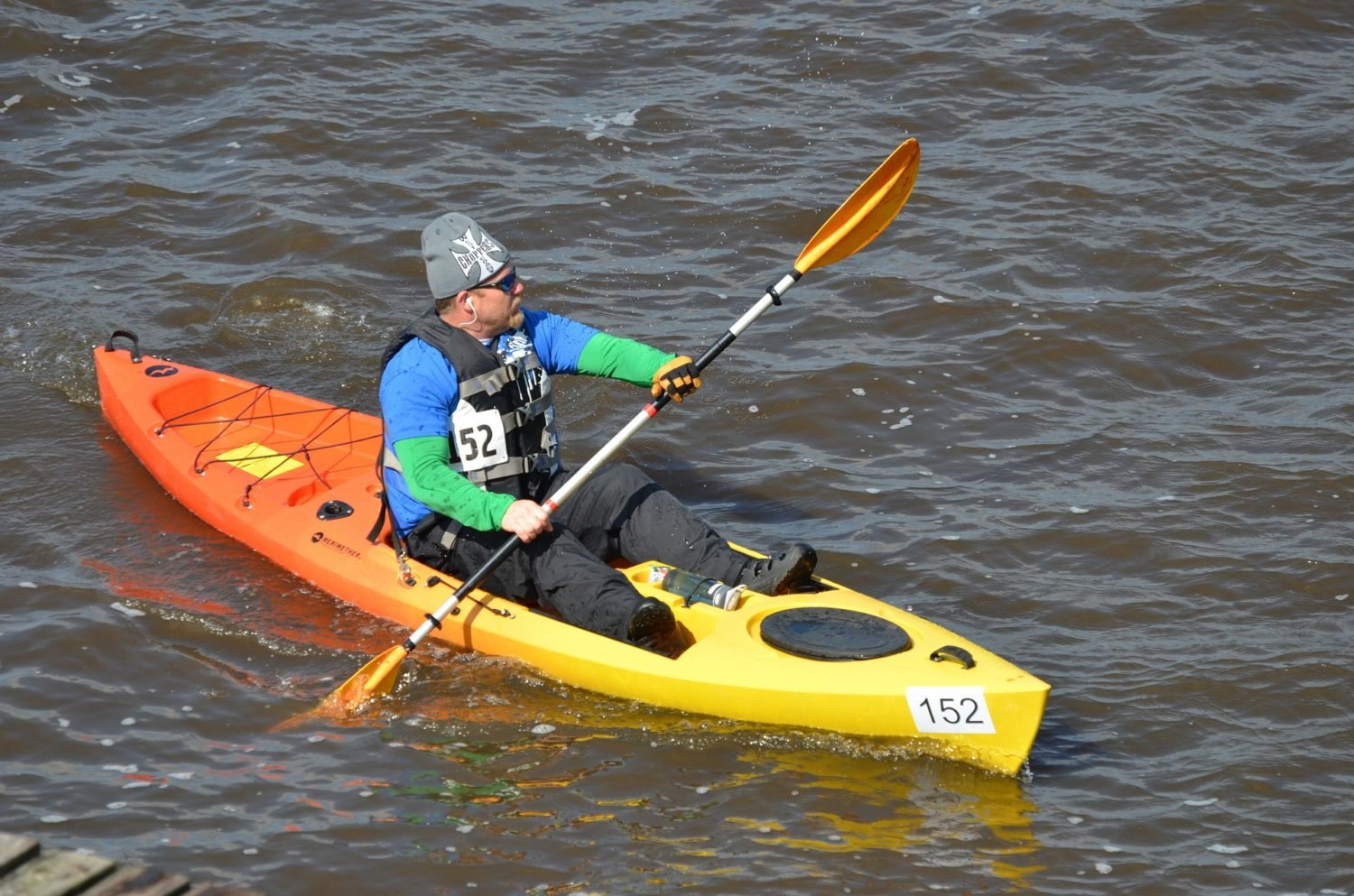19 Things To (Really) Know About Kayaking
So, a friend invited you out kayaking this weekend for the first time, huh?
Don’t know where to start? As with any new sport, there are a lot of things to know about kayaking, especially if you’re a beginner.
Kayaking really isn’t that hard, provided you keep the following tips in mind.
There are lots of lists of kayaking tips online; ours is a little different. Here’s what you really need to know — in no particular order — if you’re headed out on the water for the first time.
Kayaking for dummies: American Paddler’s 19 essential tips

1. Hold the paddle correctly
Pro tip number one: A kayak paddle is different than a canoe paddle. Use two hands, shoulder-length apart, with an overhand grip on the paddle shaft. Don’t dip the paddle blades straight down into the water; rather, use an angled dip with the blade just beneath the surface.
2. Invest in a dry storage bag
If you’re bringing a cellphone (and you are), you’ll want to make sure those precious electronics are protected. A good dry storage bag for kayaking is essential, and you can pick one up pretty cheaply, too.
3. Check the water before you go
One of the most important considerations when you’re kayaking is the type of water you’ll be paddling. Hypothermia isn’t fun, and regardless of how warm the air is, if it’s cold water (under 70 degrees), you’ll want to bring a wetsuit. If you end up in the water for whatever reason, you’ll be glad you had one.
And this goes without saying: If you’re a beginner, it’s best to stay close to shore and avoid rapids or choppy water your first time out.
4. Choose the right kayak
If you’re renting a kayak, chances are you’ll have a few different boat styles to choose from. American Paddler has a definitive guide to the different types of kayaks, but in general, a recreational kayak will suit most beginners. If you’ll be paddling calm waters, you probably don’t need a sea kayak.
5. Bring a paddle leash and a bilge pump
It’s one of those things most kayakers don’t think about until it’s too late, but what happens if you drop your paddle overboard? If you bring a paddle leash, nothing. If you don’t, well, you might be up a creek.
Similarly, unless you’re paddling in a puddle (or using a sit-on-top kayak), you’re likely to get at least a little water splashing into the boat. Bring a handheld bilge pump to keep the cockpit dry and avoid bogging down. And if the waves are really significant, use a spray skirt.
6. Adjust the seat and foot pegs
Just as every person is different, every kayak is different. What most people don’t realize is a lot of kayaks can be adjusted to fit the paddler. Before you head out, adjust the seat and foot pegs to make sure you’re comfortable. It’s a lot easier to do on shore than out in the water when your back starts cramping up.
7. Paddle with your body, not your arms
Trust me on this one. If you want to last more than 15 minutes, learn to harness the power of torso rotation when you’re paddling. In a kayak, your legs are always pointed forward, but your upper half shouldn’t be. Twist your body when you paddle, reaching the blade toward the rear of the kayak. If your stroke is all arms, you’ll quickly tire out (unless you’re this guy).
8. To twist or not to twist?
Your paddle, that is. One of the first things many new kayakers notice is that some kayak paddles can be offset (called “feathering”), with the blades at a 45-degree angle from one another. One of the reasons for this is to cut down on wind resistance while paddling, but you don’t always need it. See what’s comfortable for you.
9. Stay away from swans.
They’re mean. Enough said.
10. Wear a hat, sunglasses and sunscreen
It’s brutal out there, especially if you’re a pasty white guy like me. Even if you think you don’t need it, remember that being out on the water amplifies the sun’s strength. Even if you leave them in the kayak’s dry storage, you’ll be happy you brought them.
11. Wear bright clothing for safety
If you’ll be paddling on any waters where motorized boats travel (such as a lake), wear bright clothing. A kayaker sits pretty low on the water, making it harder for larger boats to see you. Bright clothing (and a bright kayak) is a critical safety measure to make sure you’re as visible as possible out there. Also consider a kayak visibility flag.
12. Bring the right lifejacket
According to the American Canoe Association, almost one-half of kayak-related deaths involve people not wearing a personal flotation device (PFD), and experienced kayakers are four times more likely to wear one. There’s no excuse. It could save your life in an emergency, especially if you’re knocked unconscious.
That said, a PFD doesn’t have to be uncomfortable. A U.S. Coast Guard Type III PFD can be specifically designed with kayakers in mind; they’re shorter with larger arm slots to allow for unrestricted arm rotation. Pick one up before you head out.
13. Wear gloves to prevent blisters
Whether you’re kayaking in warm or cold weather, a good pair of kayaking gloves can save your hands from the elements — or from themselves. It’s not uncommon to develop blisters after even just a few hours of kayaking, and kayaking gloves are designed to make gripping the paddle easier.
If it’s cold, you’ll definitely want a pair of good gloves, as your hands are the most exposed part of your body out on the water. Different gloves are designed for different conditions, so make sure to pick a pair that’s right for you.
14. Know your roll
Your kayak roll, that is. Safety techniques such as the Eskimo roll can help a capsized kayaker easily right a tipped boat. Don’t just rely on YouTube videos; take a class where a trained instructor can help you get this technique down. Not all kayaks can be rolled, however. Wider and flatter kayaks (such as most recreational kayaks) may be very difficult to roll, and should not be attempted.
If you don’t have time to learn, at least take a few minutes to brush up on what to do should the unexpected happen. A wet exit is much easier than a full-blown roll, but still requires a calm presence should you find yourself upside down in the water.
15. Know how to get back in
Should you find yourself needing to perform a wet exit, the next thing you’ll want to know is how to get back into your tipped kayak. There are many ways to do this, but the easiest way is to rely on the help of a fellow paddler to steady your boat as you climb back aboard. Center your weight over the cockpit as you boost yourself up, careful not to fall overboard on the other side or tip the kayak again.
If the kayak is too swamped, it may not be possibly to re-enter from the water. In this case, your best option is to swim to shore if possible.
16. Dress appropriately for the weather, too
Even if the water is warm and you don’t think you’ll need a wetsuit, make sure to pack a long-sleeved shirt. It’s often windier on the water than on shore, and you never know when you’ll be glad you had that extra layer.
17. Don’t drink and paddle
Yes, it’s a buzz kill. But alcohol and watersports really shouldn’t mix. Save the drinking for after you’re back on shore. Whenever there’s water involved, you don’t want your reaction times impaired.
18. Kayak with a partner
Especially for a beginner, a fellow kayaker can be invaluable asset. It’s not just a safety precaution; a fellow kayaker can also help should you find yourself needing to retrieve a lost paddle, re-enter your boat or even reach something in your dry storage compartment while out on the water.
Kayaks come in both single and tandem models, and tandem kayaking can be very enjoyable. Check it out!
19. Take time to enjoy it
If you’re too concerned about paddling fast, you’ll wear yourself out — not to mention miss out on the gorgeous scenery around you. You’re out here for fun, after all, so act like it! Take time to relax, and don’t worry if you’re doing everything right. Let the kayak do the work, and kick back and enjoy yourself.



Generally good tips but a few added cautions: 1) dress for the water, not the weather; also a feathered paddle works better against a wind off the bow, while the edge is cutting through the wind from the bow, the alternate, feathered blade is broadside to side winds, strong ones which can push you over without a good brace…there’s always more to think about than the simple instructions given….Be safe and have fun!